 King of France from 1515 to 1547,Francis I passed down to posterity thanks to the battle of Marignan, won by the "king-knight" in 1515. A great lover of women and hunting, great prince of the French Renaissance and protector of the arts and letters, his reign had a profound effect on the sixteenth century. The influence of the nobles diminished to the benefit of the monarch, and in 1539, thanks to the ordinance of Villers-Cotterêts, French became the language of official acts. However, of this tall young man of two meters of which he did not have a good opinion, his predecessor Louis XII will say:"this big boy will ruin everything". And in fact, François I will repeatedly plunge the kingdom into a very perilous situation.
King of France from 1515 to 1547,Francis I passed down to posterity thanks to the battle of Marignan, won by the "king-knight" in 1515. A great lover of women and hunting, great prince of the French Renaissance and protector of the arts and letters, his reign had a profound effect on the sixteenth century. The influence of the nobles diminished to the benefit of the monarch, and in 1539, thanks to the ordinance of Villers-Cotterêts, French became the language of official acts. However, of this tall young man of two meters of which he did not have a good opinion, his predecessor Louis XII will say:"this big boy will ruin everything". And in fact, François I will repeatedly plunge the kingdom into a very perilous situation.
François d'Angoulême, future François I
Born September 12, 1494 in Cognac, François d'Angoulême is a blood prince, first cousin of the King of France Louis XII. He was brought up by his mother Louise de Savoie, who entrusted him to the good care of Marshal de Gié. If the prince is studious and quite diligent, only military and physical exercises attract him. An excellent rider, he proved to be skilled in wrestling and racing, which he dominated with his large size. In the shadows, his mother, who has transferred all her ambitions to her son, prepares him for the exercise of power. François is not destined for the Crown, however.
 Yet in 1506, Louis XII still had no male heir. Worried about his succession, the king resolves to organize the engagement of his daughter Claude with François d'Angoulème. Appointed commander-in-chief of the army of Guyenne, the young prince attends the king's council and follows him everywhere in first place. After the death of Louis XII, François Ier became king and was crowned in Reims on January 25, 1515. On February 15, he solemnly entered Paris, at the head of a sumptuous procession, lending himself with good graces to the festivities that were given to him. had prepared.
Yet in 1506, Louis XII still had no male heir. Worried about his succession, the king resolves to organize the engagement of his daughter Claude with François d'Angoulème. Appointed commander-in-chief of the army of Guyenne, the young prince attends the king's council and follows him everywhere in first place. After the death of Louis XII, François Ier became king and was crowned in Reims on January 25, 1515. On February 15, he solemnly entered Paris, at the head of a sumptuous procession, lending himself with good graces to the festivities that were given to him. had prepared.
Beginning of reign of François I
As soon as he ascended the throne, he distributed his largesse, first to his mother on February 4, 1515, by erecting the county of Angoulême as a duchy, to which he added Anjou, the counties of Maine and Beaufort, then to his sister Marguerite by allocating to her the income of the Duchy of Berry, finally to her childhood and adolescence comrades such as Bonnivet and Robert La Marck. Then he set up his government and organized his court, granting Louise the title of Madame and appointing her regent whenever her travels required it. This pushed forward her trusted man, who was to be the soul of the new regime and the architect of absolute power, an Auvergne jurist named Antoine Duprat.
To replenish the Treasury, the great corps were confirmed in their offices for a fee and new charges were created. As for the Court, a concept still imprecise at that time and imported from Italy, it was made up of great lords and their wives who followed the king in his travels, in particular during the solemn entries into the cities of the kingdom. The young Claude, shy, withdrawn and already pregnant, hardly appeared there:in August 1515, she gave birth to a little girl called... Louise.
Prepared for military science and his profession as king, the young Francis I was burning to prove himself. What ground was more propitious to fight than the Milanese, on which, like his predecessor, he judged his rights and whose admirable culture he knew?
The Italian mirage
Rich and splendid since the beginnings of the Renaissance, the Italian peninsula is coveted by the European powers, in particular the sovereigns of France. Also, since the reign of Charles VIII, France is in open conflict with the pope and the Italian principalities, allied with European princes in a Holy League. In 1499, Louis XII conquered the Milanese, but had to restore it after the defeat of Novare (June 6, 1513). Having granted himself the rights of his wife Claude to the duchy, François I in turn sought to attach it to the royal domain.
 After securing the neutrality of Henry VIII of England and the support of the Venetians, the young The king launched an expedition in 1515. The superiority of the French artillery ensured him the victory of Marignan over the Swiss mercenaries, allies of the Duke of Milan. This military success gave François I, twenty-year-old king, dubbed a knight on the battlefield by the Lord of Bayard, immense popularity and a flattering reputation for bravery.
After securing the neutrality of Henry VIII of England and the support of the Venetians, the young The king launched an expedition in 1515. The superiority of the French artillery ensured him the victory of Marignan over the Swiss mercenaries, allies of the Duke of Milan. This military success gave François I, twenty-year-old king, dubbed a knight on the battlefield by the Lord of Bayard, immense popularity and a flattering reputation for bravery.
The enemies of the day before must then negotiate with the King of France:Pope Leo X treats with François Ier in Bologna, the Swiss sign a perpetual peace - which allows France to henceforth raise troops of mercenaries - and Charles Ier to Spain (future Charles V) recognizes France as the Milanese against maintaining his rights over the Kingdom of Naples.
The rivalry with Charles V
Candidate in 1519 to the throne of the Holy Roman Empire, Francis I was preferred by the Imperial Electors to King Charles of Spain, who, thanks to the gold of the Fuggers pledged on the mines of the New World, enjoyed a power well superior to that of the King of France. The expansionist aims of Charles V (“Always more oultre”, always further) put the sovereign of France in danger:grandson of Charles the Bold, Charles seeks to annex Burgundy; Emperor of the Holy Empire, he claims suzerainty over the former possessions of Dauphiné and Provence.
From then on, surrounded on all sides by a sovereign who reigned simultaneously over Spain, Flanders, the Empire and a large part of Italy, Francis I never ceased to forge alliances with the princes strangers. However, after the costly and useless interview at the Cloth of Gold camp (June 1520), where he failed to obtain the support of Henry VIII of England, he found himself forced into war with the Emperor. /P>
 As part of the Italian wars, hostilities between the two sovereigns began in 1521. Very quickly, the operations turn against France:the defeat at La Bicoque (1522), where Bayard is killed, delivers the Milanese to the imperials. The following year, the constable of Bourbon, grand commander of the royal army, betrayed his sovereign, entered the service of Charles V and unsuccessfully attempted an invasion of Provence.
As part of the Italian wars, hostilities between the two sovereigns began in 1521. Very quickly, the operations turn against France:the defeat at La Bicoque (1522), where Bayard is killed, delivers the Milanese to the imperials. The following year, the constable of Bourbon, grand commander of the royal army, betrayed his sovereign, entered the service of Charles V and unsuccessfully attempted an invasion of Provence.
Finally, in 1525, following the disaster at Pavia, the king himself was captured by the emperor's troops; as the king himself wrote to his mother:"Of all things, only honor and life remain to me." During her imprisonment, Louise of Savoy ensured the regency in dramatic conditions which are reminiscent of the captivity of John II the Good during the Hundred Years War.
Detained in Madrid, Francis I had to sign the Treaty of Madrid on January 14, 1526, which ceded Milan and Burgundy to the Empire, promises from which he freed himself upon his release, thus relaunching the war. After the alliance contracted in Cognac by Francis I, the Pope, Venice and Duke Sforza of Milan (May 1526), the imperial troops sacked the Eternal City (1527), and the Pope had to sign a humiliating treaty with Charles V .
This is why, in order to limit warlike operations in northern Europe, Louise of Savoy and Margaret of Austria, aunt of Charles V, agreed during the Treaty of Cambrai (1529):confirmation of French possession of the Burgundy against the abandonment of Italian pretensions; the following year, the marriage of Francis I, a widower since 1524, with the emperor's sister, Éléonore de Habsbourg, herself widow of Manuel I, king of Portugal, the peace of the ladies seemed to confirm this improvement.
New alliances
However, aware of the fragility of this appeasement, Francis I worked to conclude new alliances and offered in 1531, to the great scandal of Catholic Europe, his support for the League of Smalkalde, formed against Charles V by the Lutheran princes Germans. On the other hand, in 1535 he signed a treaty with Suleiman the Magnificent, like him desirous of weakening the power of the Habsburgs; the war then resumed the following year when the emperor invaded Provence. Rejected by Duke Anne de Montmorency, who obtained the office of Constable in 1537, Charles V was forced to sign a ten-year truce at Aigues-Mortes (1538).
 But, as Montmorency's diplomatic policy for obtaining the Duchy of Milan remained futile, Francis dismissed him and relaunched the conflict from 1542. Faced with the Anglo-Germanic coalition, the French troops retook Nice with the support of the Turks in 1543; the following year, the king was victorious at the battle of Cérisoles.
But, as Montmorency's diplomatic policy for obtaining the Duchy of Milan remained futile, Francis dismissed him and relaunched the conflict from 1542. Faced with the Anglo-Germanic coalition, the French troops retook Nice with the support of the Turks in 1543; the following year, the king was victorious at the battle of Cérisoles.
However, threatened with an invasion of the kingdom because of his alliance with "infidels", he signed the treaty of Crépy with Charles Quint (1544), then that of Ardres with Henry VIII (1546). Putting an end to a ruinous war that failed to shake the balance of the Habsburg Empire, these agreements confirm the abandonment by France of Savoy, and the loss of Artois and Flanders.
Francis I, prince of the Renaissance
These multiple expeditions very quickly brought the French sovereign into contact with the Italian Renaissance. Francis I, marked by the refinement of his education, was very sensitive to this renewal that he sought to introduce into his kingdom.
He then became the protector of the intellectuals, in particular the humanists of the cenacle of Meaux, who already received all the sympathy of Marguerite d'Angoulême. The humanist theologian Lefèvre d'Étaples becomes tutor to the king's children; the scholar Guillaume Budé receives the task of creating a royal library in Fontainebleau, ancestor of the National Library; then, in 1530, he had to organize a trilingual college, the future College of France, in which the royal readers taught Greek, Hebrew and Latin. At court, the monarch welcomed poets such as Mellin de Saint-Gelais or Marot, to whom he gave official positions.
Similarly, the king attracted great Italian and foreign artists to France, such as Jean Clouet (official painter to the king from 1516 until his death), Fiorentino Rosso (who replaced the first from 1530 until his death), Primaticcio (painter, decorator and architect who arrived in France in 1531) or Benvenuto Cellini (guest sculptor from 1540 to 1545). Through this policy of invitation, François I inaugurates the royal patronage, taken over by his successors, in particular Louis XIV.
 But it was undoubtedly by welcoming Leonardo da Vinci in 1516 that Francis accomplished this desire to adapt to the France Renaissance art. After having installed the Florentine artist in the Château du Clos-Lucé in Touraine, he commissioned many works from him, including the construction project for the Château de Chambord.
But it was undoubtedly by welcoming Leonardo da Vinci in 1516 that Francis accomplished this desire to adapt to the France Renaissance art. After having installed the Florentine artist in the Château du Clos-Lucé in Touraine, he commissioned many works from him, including the construction project for the Château de Chambord.
A great builder, the king also built the royal residences of Saint-Germain, Villers-Cotterêts and Madrid (in Neuilly). He redecorated the Château de Fontainebleau (Rosso for the royal gallery, the Primaticcio for, in particular, the ballroom) and the Château de Blois (construction of the openwork staircase) in the Italian style. It was under his reign that the school of Fontainebleau found its full development.
Also influenced by Italian tastes in the art of appearance, Francis I considerably developed the court. Center of sumptuous and social life, it moves according to the pleasures of the king in the sumptuous castles. The king multiplies the festivals, concerts and theatrical compositions inspired by Italian culture, while preserving the traditional ceremonies of the Middle Ages (royal entries into the cities, tournaments and hunting).
A lover of pleasures, he maintained numerous liaisons, the most notable of which were the Countess of Chateaubriand and then the Duchess of Étampes. By attracting the nobility in this way, by multiplying the pledges and favors, the sovereign obtains better control of this traditionally turbulent order.
Money, the sinews of war
On his return from captivity in Spain, Francis I had taken over the reins of the kingdom with a firm hand and, money deciding wars, he considered it essential to have financial resources at his convenience, the key to any policy. The financial problem had arisen for all the Valois. Traditionally, the royal treasury had two kinds of resources:ordinary revenues, coming from the private domain of the king, and extraordinary revenues, which, from exceptional, were not long in becoming ordinary and soon constituted nine tenths of the resources (aid on wine or on cloven-footed animals, tolls, salt tax and, finally, the worst supported of all, the size with its increases, its "floods" raised as and when needed). The size did not affect the king's subjects as well, since nobles, clergymen, most of the king's officers and townspeople were exempt from it.
 Unstable, arbitrary, the size could vary according to the "generalities" where treasurers and finance generals operated. So the treasury never knew its recipes exactly. He was content to state his demands, with the mission for the treasurers or their tax collectors and collectors to manage with the taxpayers at the level of the parishes.
Unstable, arbitrary, the size could vary according to the "generalities" where treasurers and finance generals operated. So the treasury never knew its recipes exactly. He was content to state his demands, with the mission for the treasurers or their tax collectors and collectors to manage with the taxpayers at the level of the parishes.
The treasurers and "generals" were in a way the grand masters of finance. They most often belonged to banking families and they provided or lent to the king as and when needed. The Beaunes, the Briconnets, the Berthelots thus held enormous power as the king's creditors, for, despite all sorts of expedients, creation or sale of offices, loans from the cities, the Crown had to rely on them in the end. /P>
The most eminent personage of this oligarchy was a wealthy merchant, Jacques de Beaune de Semblançay, whom Francois I had named "general" and had made a sort of Superintendent of Finances. But, from 1521, however skilful he was, Semblançay succeeded less and less easily in coping with the growing demands of the king, who had to pay his soldiers. He was able to send another 360,000 livres to the army in Italy, but he refused to absorb the following deficit. “The purses are closed,” he wrote to the king.
Pushed by Louise, Francois thought he had been fooled and he began a first trial against his financier in 1524, a trial which turned to Semblançay's advantage and cleared him of the accusations. But the King of France did not intend to stop there.
In 1527, he had him arrested again and he constituted the commission of the “Square Tower” composed of members entirely in his service. The trial lasted several months and its outcome was tragic:convicted of fraud, Semblançay was hanged on August 12, 1527 from the gibbet of Montfaucon, while Marot composed an epigram in his honor that has remained famous... Semblançay was not alone in paying the price of his power. Bohier, Berthelot, Ruzé, Poncher were in turn condemned to enormous fines, but rarely to capital punishment. After freeing himself from the tutelage of parliament, Francis had just freed himself from the financial oligarchy. All that remained was to undertake a general reform.
The consolidation of the monarchy
Tall and elegant, intelligent and calculating, although often impulsive and superficial, endowed with a poise noticed by all the memoirists of his time, Francis I was a majestic sovereign, with a high idea of his office. Absolutism experienced undeniable progress through the strengthening of administrative centralization, the development of Court life - it was François I who forged the formula "for such is our pleasure" and the imposed expression "His Majesty".
The king governs personally, although assisted by a Council (known as the Privy Council or Council of State), which is made up of the royal family, princes of the blood, high officers and a few old servants. The members of the Privy Council only take part in the government if they are admitted to the Business Council, a small, very closed circle where the king and one of his advisers dominate.
 Dominated by warlike concerns, the reign of Francis I was characterized by a strengthening of royal authority, prefiguring absolutism:the confiscation of the property of the constable of Bourbon (1523), the definitive reunion of Brittany in the kingdom (1532), the affirmation of royal justice in the face of seigniorial justice, the prohibition made to parliaments to use of their right of remonstrance - leaving them only the right of registration - the sending of intendants to the provinces, the ordinance of Villers-Cotterêts (1539) - imposing, among other things, the drafting of legal and notarial deeds in French and no longer in Latin-, are so many affirmations of a desire for unification and centralization, including the king's great advisers, the Duke of Montmorency, the Lord of Bonnivet (v.1488-1525) and the Admiral Philippe de Chabot (v.1480-1543) are the faithful interpreters.
Dominated by warlike concerns, the reign of Francis I was characterized by a strengthening of royal authority, prefiguring absolutism:the confiscation of the property of the constable of Bourbon (1523), the definitive reunion of Brittany in the kingdom (1532), the affirmation of royal justice in the face of seigniorial justice, the prohibition made to parliaments to use of their right of remonstrance - leaving them only the right of registration - the sending of intendants to the provinces, the ordinance of Villers-Cotterêts (1539) - imposing, among other things, the drafting of legal and notarial deeds in French and no longer in Latin-, are so many affirmations of a desire for unification and centralization, including the king's great advisers, the Duke of Montmorency, the Lord of Bonnivet (v.1488-1525) and the Admiral Philippe de Chabot (v.1480-1543) are the faithful interpreters.
At the same time, the founding of the port of Le Havre by Bonnivet (1517), the encouragement given to the explorer Jacques Cartier mark the concern for power to open the kingdom to the outside world and to participate in colonial expansion.
While the cost of wars constantly forces new expedients to be found, the policy followed in financial matters seems less coherent. No coherent tax system was put in place and, to satisfy his large needs for money (paid to win over the German princes when he applied for the Empire and for his patronage), he pressured his subjects. The size passes, between 1517 and 1543, from 2,400,000 to 4,600,000 pounds.
While the creation of the Treasury of Savings (1523) made it possible to improve the collection and yield of taxes, urgency often required the contracting of heavy loans, recourse to massive sales of offices, encourage inflation and multiply the titles (such as rents on the Town Hall, created by Chancellor Antoine Duprat in 1522) which permanently burden the state budget. This superposition of provisional measures, immediately made permanent, remained one of the constants of the French tax system until the French Revolution.
Francis I, religious leader
From the beginning of his reign, François Ier wanted to assert his sovereignty over the three orders:the nobility, the third estate but also the clergy. In 1516, he met Pope Leo X and obtained, with the signing of a concordat, the right to appoint bishops in his kingdom. This concordat of Bologna ensures him, in spite of the capacity of confirmation recognized to the pope, the control of the French episcopate. At that time, many people among the clergy and in the world of thought had realized the need for reform in the Church.
Ignorance, extortion, laxity of morals very often characterized the priests who sometimes no longer even knew how to recite the creed. The papacy was struggling to recover from the moral abasement in which its magisterium had fallen, the bishops were looking for benefits and the traffic in indulgences was the pretext chosen by Luther to set fire to the powder and launch the Reformation.
In religious matters, the king shows, initially at least, a certain tolerance vis-à-vis the Protestants; close to the humanists of Meaux - animated by the bishop Guillaume Briçonnet, spiritual director of Marguerite d'Angoulême -, the king works in their favor when they are suspected of Lutheranism by the Sorbonne. In the 1530s, through his desire for political rapprochement with the German Lutherans, he stifled the various religious scandals.
But, after the Placards affair (October 1534), the king became aware of the extent of the movement and allowed Parliament to trigger a wave of persecutions, which the edict of Coucy suspended by diplomacy (July 1535). Reinforced by the edict of Fontainebleau in 1540, the persecution soon resumed with, as a terrible illustration, the massacre of several hundred Vaudois in Provence in April 1545. Ultimately, even if he occasionally protected a few relatives or intellectuals, François I was remained faithful to Rome throughout his reign. The Affair of the Placards revealed for the first time that Protestantism had found a real foothold in France—its status was to be the great question posed to the French monarchy for a century.
Worn down by syphilis, François I died on March 31, 1547 in his château de Rambouillet. The Dauphin François having died in 1536, his second son, aged 28, acceded to the throne under the name of Henri II.
Bibliography
- Francis I:A King Between Two Worlds, by Cédric Michon. Belin, 2018.
- François I, biography of Didier Le Fur. Perrin, 2015.
- Francis I, by Pascal Brioist. PUF, 2020.
